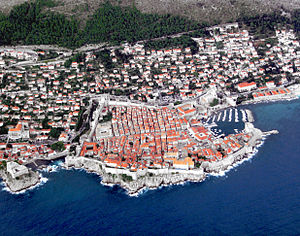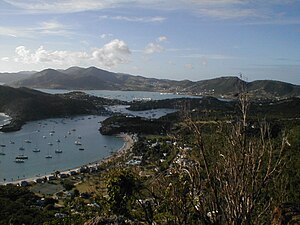 |
| English: Dubrovnik from the aeroplane. (Photo credit: Wikipedia) |
| English Harbour (Photo credit: Wikipedia) |
When I was watching the swifts doing
their enchanting perambulations across the Old Town of Dubrovnik the other
morning, I remarked that it reminded me of when I watched frigate birds, in
similar circumstances, in the island of Antigua back in 1974.
I had taken my whole family --- then
early-teenagers --- for a holiday, with the intention of writing a book.
Miraculously we managed to hire a beachside cottage around the corner from
English Harbour in the south of the island, for $250 a month. (The next time we
returned to Antigua five years later, the same cottage was renting for $250 a
day.) Every morning I would write my book between 6 am and noon, while my wife
would take the children off to one or other of Antigua’S 365 beaches, and at
noon we would all pile into our mini-moke, drive up through the island to St.
John’s, the capital, where we would go for lunch to the garden of the Kensington
Palace Hotelk,m where a grouop of civil servants would emerge from their
surrounding offices to play in a steel band over the lounch hour, while we
drank rum and ate club sandwiches to our heart’s content,before taking off for
one of the beaches where we would spend the afternoon in the sun. These are
memories of happy times that have never left me: perhaps because I succeeded in
finishing the book, and returned to Montreal feeling as if I had been on
holiday, which, indeed, I had.
But before I got into this daily routine,
I would bundle up the family and drive up to watch the frigate birds take off
from the cliff above us. Our cottage lay just under a huge cliff from which, in
the evenings, just as we would be settling for our evening gin and tonic, an
army of bats would arrive to swoon around over our heads as they caught the
myriad insects that came out at that time. Very similar to what the swifts do
over Dubrovnik, or so I am told.
The cliff we drove up to was called Shirley’s Heights, where an abandoned
fortification from Napoleonic times stood on the top of the cliff, looking out
to sea for any suspicious --- namely, French! --- ships that might heave into
view. Just as the sun was rising, a flock of frigate birds would rise from the
cliff below us, soaring up into the wind as still and quiet as if asleep, never moving their huge wings as they
caught the draught, and passed us almost within touching distance until, higher
up, they caught the wind and headed off out to sea, every morning. It was such
a wonderful sight I have never forgotten it, more especially since, on our
return five years later, we discovered that the fortifications had been
restored, restaurants and other impediment had been built, and the frigate
birds had disappeared.
Oddly enough, when I looked up the
indications for swifts, frigate birds were mentioned as having something
similar to the swifts in characteristics, namely that they are both mostly
aerial creatures which can live in the air for days without ever touching down,
just like the swifts, especially those of certain species in some parts of the
world. There are five varieties of
frigate bird, and the one that hangs out around Antigua and its neiughbouring
island of Barbuda has become the subject of a scientific study which is trying
to build more knowledge about a bird whose characteristics remain largely
unknown to humans.
Swifts, apparently, in certain species,
can live in the air for weeks at a time, and have even been known to mate in
the air, as well as feed in the air from consuming insects. One Web site I read
about frigate birds indicated that they are thieves, which steal food from out
of the mouths of competing species, although in what circumstances they do this
was not clear to me. I remember that in Antigua we watched in amazement one day
as some frigate birds circled around a neighbouring bay and entertained us to
an amazing exhibition of sharp-shooting --- that is, diving from a huge height
and at a considerable speed into the water, and emerging holding a fish. So
this seems to be one feeding characteristic not much noted by the experts on
frigate birds, at least those two or three I have read.
Like the frigate birds, the swifts seldom flap their wings, but they still
manage to catch the draughts and soar at an immense speed back and forth in
what looks like gay abandon.
This morning when I awoke and opened the door to the balcony I was
almost knocked over by the wind. It is often like that for a short while in the
mornings, but the wind soon moderates, and even sometimes dies away completely,
as it has almost done already, two or three hours later. When these strong
winds occur, the swifts are not to be seen, except perhaps one or two brave ones
that have caught the wind and are soaring away up in the air above us, barely
visible to the naked eye. I find it hard to believe that insects have been able to maintain themselves in such high winds, and I have some doubt that the species of swift we see here really does get most of its food from picking off insects in the air. Maybe I will meet someone I can ask about that in the month remaining to me in this extraordinary little town.


No comments:
Post a Comment